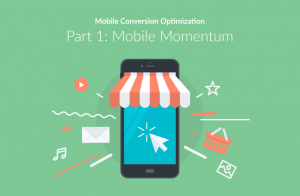I’ll let you in on a little secret: I am very excited about this article. Here’s why: I am a fan of social listening, and while social listening can be useful for almost any business, for startups, it’s no less than life-changing.
But let me start with the definition ? all great articles start this way.
What is social listening?
Social listening is the process of monitoring social media channels, news, blogs, forums, and the rest of the web for mentions of your brand, competitors, product, or any other keyword. For that, there are social listening (or social media monitoring) tools. They crawl the Internet 24/7, collect the results in one dashboard, and analyze them to turn the usually large amount of data into statistics and trends.
Why does social listening matter for startups?
1. It focuses on the online world.
Startups know that real marketing happens online. Growth and word-of-mouth happen online. Reputation happens online. And while this is true to some extent for most businesses, it’s very true for startups.
A local candy shop can get famous by giving out candies to the neighborhood, large brands can pour money into Super Bowl advertising and sponsor events, old established brands continue with TV ads mixing them up with social media and Google Ads. But while for them the online presence is just one of the marketing goals, for startups, online presence is everything. That’s where their target audience is. That’s where virality is possible. That’s the place their future customers will check before deciding to purchase.
2. It’s budget-friendly.
There are many social listening tools on the market, and really, you can find all kinds of prices. But most of them are within a range that’s affordable for new businesses, and some tools are absolutely free.
3. It’s multi-functional.
Marketing takes up so much time and money because there’s a lot, a lot to it. It’s never just advertising, or just social media, or just content. The more you do, the more has to be done. And then, it’s integrated with PR, customer service, SEO, and product development, and at some point, you realize that everything is marketing. Every activity you do should promote the selling of a product.
So, you need tools that also cover different, large parts of marketing and achieve a whole range of marketing goals. Otherwise, you’ll end up with dozens of tools, and while this might seem okay for large brands with dozens of teams and hundreds of people, this is usually not an option for startups.
Social listening is incredibly multi-functional. It performs market research, finds influencers, ensures perfect customer service, finds outlets for PR and link-building opportunities for SEO. It increases brand awareness, finds leads, finds online conversations to join in, increases engagement, and research competitors. As a single marketing tool, it covers more goals than any other.
Now, let’s get into the basics of the process, and then we’ll move on to how to achieve all these goals described above with social listening at hand.
How does social listening work?
Social listening starts with creating an alert for a keyword. A keyword can be anything, but people use more common ones to achieve certain marketing goals. They are:
1. Your brand and your product, if it has a specific name.
You should monitor mentions of your brand to:
- find users mentioning your brand and reply to their complaints or questions
- assess overall brand awareness and brand reputation
- find brand advocates
- find unlinked mentions of your brand on blogs and turn them into links
2. Your competitors’ brands.
You should monitor your competitors’ brands to:
- discover what your competitors’ customers complain about and what they praise;
- to assess your share of voice online compared to your main competitors;
- find bloggers and journalists that have worked with your competitors.
3. Your industry + “search keywords”.
You should search for a combination of your industry and the keywords that signal the user’s search intent to:
- find hot leads and topics trending around your industry;
- find relevant social media influencers.
4. Your CEO
If they are a public figure, you can monitor them to track their popularity and reputation as it can affect the startup.
Now that you’ve chosen one or several keywords from this list, create separate alerts for each one of them, and wait for the tool to gather mentions. Most social listening tools work in real-time, however, as you surely understand, crawling all of the Internet takes time even for the most powerful tools. Social media mentions get returned in real-time or close to it, but mentions from blogs, forums, news sites, and the web will come with some delay. The web takes the longest.
With some social listening tools, you can reply to mentions straight from the dashboard. You can also work with mentions: delete them, save them, delegate them to your team.
For most paid tools, mentions are not only gathered ? they are also analyzed. You receive statistics concerning your mentions: their growth, engagement level, sentiment (positive, negative, neutral), languages, locations they are coming from, and trends around them. You also receive information on mentions’ authors: in most cases, it’s their demographics. Most tools also show you a list of your social media influencers.
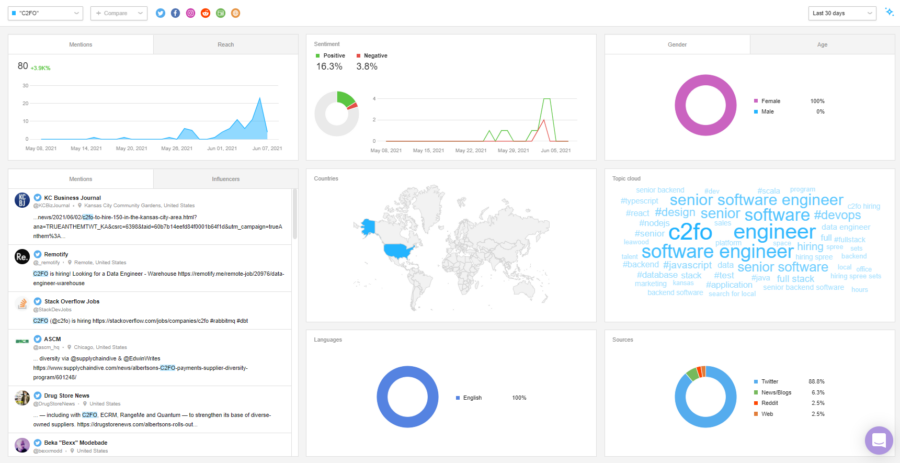
If you’re monitoring your brand and your competitors’ brands’, you can compare the two (or more) by all of the attributes described above.
How to achieve marketing goals with social listening?
Finally, we arrived at the most interesting part. How can you use all of the above to achieve marketing goals? Let’s go through marketing challenges and see how social listening can help.
Find your target audience
At the beginning of marketing, there is always a buyer persona. You imagine a person who would benefit most from your product. Based on that, you define your target audience and market to them. However, your target audience and the audience that’s actually buying your product isn’t always the same one.
Sometimes, things don’t go according to a plan, and a meditation app ends up being used not by the stressed CEOs of California, but by hippie college kids on the other side of the US. Or by CEOs in Germany. Or by mums in Russia.
Sometimes, you end up marketing to the wrong location, demographic, and psychographic, and, therefore, the market not in the right way.
When you’re monitoring your brand and brands of your direct competition, you discover where your target audience actually is and who they are. The depth of this information depends on the tool, but in most cases, you’ll know your real audience’s languages, locations, demographics, and the social media networks they use.
Let’s stop at that last point for a second. Social media networks play a huge role in your marketing, but as a startup with limited resources, you can’t possibly focus on all of them. Social listening tells you which ones you should be focusing on because that’s where your audience hangs out.
Competitor research
Competitor research is one of the hardest and most time-consuming marketing tasks. And it’s also unavoidable. You can’t define your unique selling proposition, develop your marketing strategy, and plan your PR without competitor research.
Social listening is a magic wand when it comes to competitor research. For starters, it helps you find your real target audience, as discussed above. But that’s not all. Competitor monitoring also shows:
- Competitors’ online visibility and brand reputation
- Real-user feedback on products and services
- Influencers, journalists, and media that works with your competitors
- Your own share of voice
Again, let’s stop at the last point, as the others seem clear. Share of voice is a metric that describes a share of conversations about a given brand, product, or service in comparison to its direct competitors. While your goal during competitor research is to assess the market share of each of your competitors, share of voice is the next best metric. The actual market share is pretty much impossible to assess, but the comparable level of conversation the social media and the web produces is a good marker of how known and how popular the brand is.
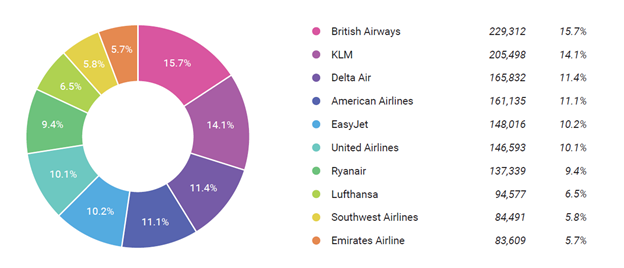
Lead generation
Lead generation might be the most demanded marketing goal. There are never enough leads. They are never easy to get. Everyone seems “cold” when it comes to selling. But the good news is that specifically for startups, social listening is amazing when it comes to lead generation.
Here’s how lead generation with social listening works:
- Create an alert with your industry keywords together with keywords that signal the search intent. For example, “fitness tracker app, recommend, looking for, good”. You’ll need a tool that has a Boolean search option that allows for creating such queries.
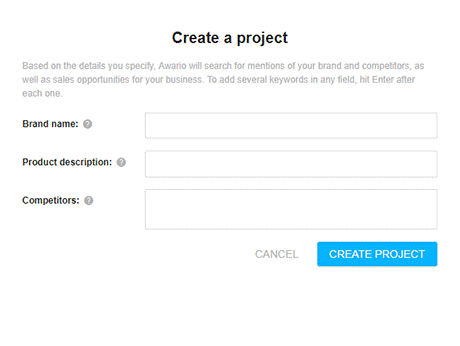
2. Once the tool finds these people, approach them as a company representative or just as another social media user with a recommendation.

3. Again, create an alert for your main competitors. Then, filter out the results to only show negative mentions.
4. Once the tool finds your competitors’ unhappy customers, also approach them with a recommendation of your product, as a random social media user or as an attentive company representative.
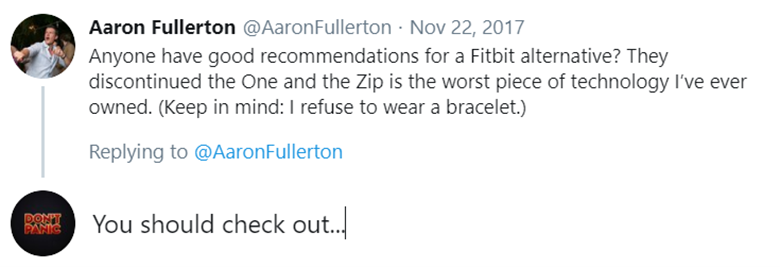
Increasing brand awareness
For startups, social media is an ideal place for increasing brand awareness. Most of social media marketing is aimed at increasing brand awareness through methods such as:
- Influencer marketing
- Creating free entertaining/educational content
- Encouraging user-generated content
- Carrying out contests
- Communicating with followers and other social media users.
These actions create a community around the brand, brand advocates, and people who unintentionally spread the word about your brand.
Social listening helps here with a number of things. Firstly, it measures brand awareness, which is vital when assessing the results of social media campaigns, as well as PR campaigns, as social listening measures brand awareness on not just social media, but also on news sites, blogs, forums, and the web.

Secondly, social listening finds conversations about your industry, which you can join in and spread the word about your brand.
Reputation management
Although it comes quite late in this list, reputation management is one of the primary goals of social listening. There is nothing specifically startup-focused here: every brand has to take care of its reputation and be instantly aware of a social media crisis breaks out.
Social listening tools break all brand mentions (if you’re monitoring your brand) into positive, negative, and neutral. This provides an instant idea of the current reputation and makes it easy to observe how it develops over time.
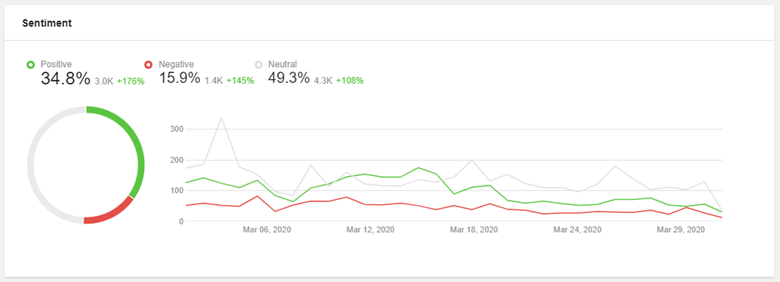
You can filter the results to only see negative mentions and reply to them, you can also see the reaction to a specific campaign, and with some tools, you get email notifications if the number of negative mentions is suddenly growing rapidly.
SEO
The role of social listening is often overlooked when it comes to SEO. This is fair, considering there are plenty of amazing SEO tools that cover all aspects of SEO that no one else will. However, if you already have a social listening tool, here’s something you can do to improve your rankings:
- Find unlinked brand mentions on blogs and news sites and turn them into links.
If your tool has a Boolean search option, you can tune it to find unlinked mentions of your brand on blogs and news sites. You can then contact the authors and ask them to add links to your brand mentions.
- Find guest posting opportunities.
Guest posting is still one of the most popular methods of link building. By monitoring the mentions of your competitors on blogs and news sites, you’ll find sources they’ve written for. This usually means that you can reach out and successfully guest post there, too.
Final words
The benefits of social listening are almost endless. It’s one of those exciting methods that instantly bring to life the trends of the past couple of years: implicit marketing and deep data analysis. Hopefully, this article made it easy for you to get started. And if it didn’t ? just get started anyway. I promise, you’ll get into social listening very quickly.
Digital & Social Articles on Business 2 Community
(23)




